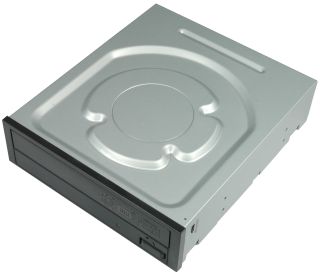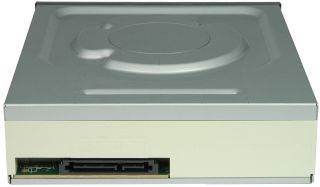Three Generations Compared: Is Your DVD Burner Outdated?
Sony Optiarc AD-7240S (2009, 24x)

Lastly, we used the AD-7240S, which is an offspring of Sony Optiarc’s latest optical drive family. As you can see, the manufacturer name has changed again; this is because Sony took over the entire optical drive business by the end of last year.
Parallel ATA drives have finally gone away, but there are still two different models: the AD-7241S supports LightScribe while the AD-7243S handles Labelflash. We received the AD-7240S, which doesn’t support either disc labeling technology. We can’t help but wonder if it would be simpler and easier to offer only one model that supports both approaches.

This latest drive supports up to 24x recording, which equals 31.68 MB/s (given 1.32 MB/s throughput for 1x DVD speed). While the 18x drive had to reduce speeds by the end of the recording process, this latest model actually maintained its rotation speed almost all the way through. Speeds dropped from 24x to roughly 20x for the last 150MB of data, but the overall write performance was still impressive. Four minutes and 13 seconds is a decent improvement over 5:29 on the 18x drive and 6:18 on the 16x model. We also found that this latest drive consumes a bit less power, despite its higher performance.
We’ve had issues with recording DVD-9 double-layer discs, as we could not obtain any media capable of supporting more than 8x recording speed. As a result, the recording time is similar to the older drives. In fact, it’s even a bit slower. We verified this several times. It appears that 12x double-layer recordable media is practically non-existent in North America or in Europe. Even if we found the discs, we’d have to pay Blu-ray recordable prices for the high-speed DVDs, which doesn’t make sense.


Stay on the Cutting Edge
Join the experts who read Tom's Hardware for the inside track on enthusiast PC tech news — and have for over 25 years. We'll send breaking news and in-depth reviews of CPUs, GPUs, AI, maker hardware and more straight to your inbox.
Current page: Sony Optiarc AD-7240S (2009, 24x)
Prev Page Sony NEC Optiarc AD-7173A (2006, 18x) Next Page Comparison Table And Test SetupMost Popular

